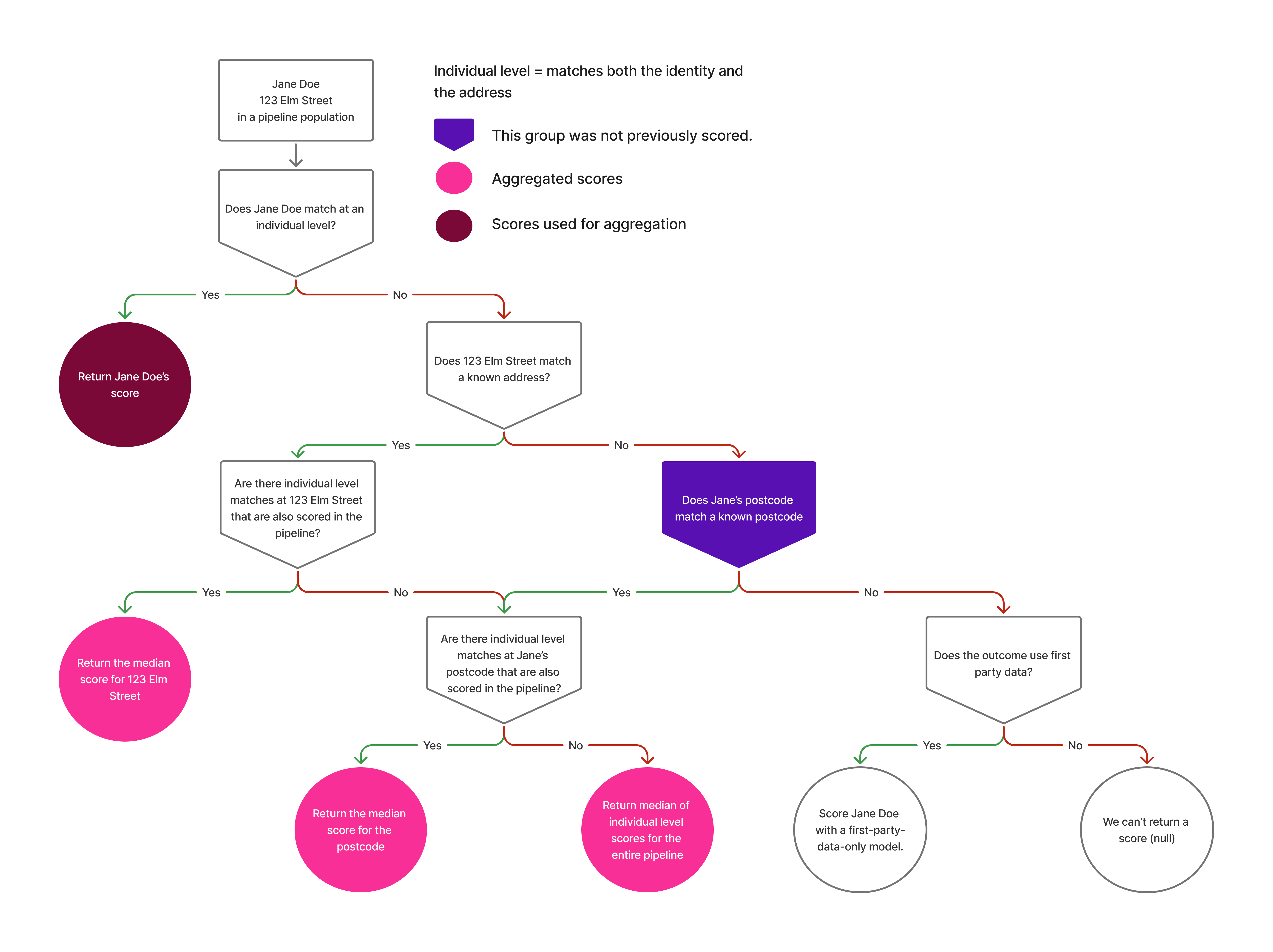Noticed a change in your score reporting? Here’s how score aggregation is improving your results
Score aggregation improves prediction accuracy and stability by averaging scores from similar groups rather than estimating individual scores from aggregated datapoints.



Score aggregation is a method we use to enhance the accuracy and stability of predictions when individual-level data is incomplete. Instead of relying solely on aggregated datapoints—an approach that works great when appending data but can introduce volatility in model outputs when scores are produced with these aggregated inputs—we take the next step and aggregate scores themselves. This ensures that models can still generate high-quality predictions, even when full individual identity resolution isn’t possible.
By leveraging aggregated scores, we can create smoother, more consistent predictions across varying levels of enrichment. This builds on our existing strategy of using aggregated datapoints for data appends but tailors it specifically for improving modeling outcomes.
A simple example
Sounds a little complicated? It’s actually easier than you think! Let’s break this down with a simple scenario that unpacks two hypothetical individuals:
John Doe – Fully identified
John lives at 456 Oak Street, and we have all the necessary PII to match him confidently in our system. Because of this, we can generate a highly individualized score based on his specific datapoints and history no problem. This is how our identity resolution process ideally works.
Jane Doe – Partially identified
Jane, on the other hand, lives at 123 Main Street, and we don’t have enough personal information to fully match her. However, we do know a lot about her household. Previously, we would have used aggregated datapoints from the household (or street, postal code, depending on how far out we’d need to go to find accurate information) to generate her score, but this could result in fluctuations.
Now, instead of scoring her based on those aggregated datapoints directly, we leverage an aggregated score—we average the scores of people in similar groups (in this case her household) rather than creating an average person based on datapoints and then scoring that, itself. This provides a more stable and accurate prediction, reducing potential variability and improving reliability.
So how does it affect you?
The key impact of score aggregation is that it makes every model better. However, you might also notice changes to individual scores, and here’s why:
- More reliable predictions: Instead of introducing potential spikes from scoring based on aggregated datapoints, we now rely on aggregated scores, which reflect a more stable signal.
- More inclusive modeling: Even when we can’t fully identify an individual, we can still provide a meaningful prediction using data from their household or surrounding population.
- Fewer gaps in data: If a person’s identity is incomplete, we don’t discard the opportunity to score them—instead, we use the best available aggregated score to fill in the blanks.
Key considerations
When implementing score aggregation, there are a few key considerations to keep in mind. First, using aggregated scores helps prevent sudden shifts in predictions that might occur when only aggregated datapoints are used. This approach provides a more stable and reliable signal. Second, our methods adapt based on the available data: when full PII (Personally Identifiable Information) is available, we prioritize direct individual scoring. However, when only partial data is present, aggregated scores serve as a reliable fallback. Lastly, if only household-level data is available, rather than estimating an individual’s score based on household datapoints, we derive a score from the averaged predictions of others in similar households, ensuring that the prediction remains accurate and meaningful despite incomplete individual information.
In conclusion
By adopting score aggregation, we ensure that models remain robust and useful even when some data points are incomplete. This helps businesses make better decisions with confidence, regardless of data availability. If you'd like to learn more about how this—and the numerous other services and AI use cases that Faraday provides—could benefit your business, reach out!

Thibault Dody
Thibault is a Senior Data Scientist at Faraday, where he builds models that predict customer behaviors. He splits his time between R&D work that improves Faraday's core modeling capabilities and client-facing deployments that turn those capabilities into real results. When not deploying ML pipelines, he's either road cycling through Vermont or in the shop turning lumber into furniture, because some predictions are best made with a table saw.

Dr. Mike Musty
Michael Musty is a Data Scientist at Faraday, where he partners closely with clients to prototype and build on the Faraday consumer prediction platform. His work ranges from general guidance to technical custom solutions, and he also contributes to feature development, research, and implementation across Faraday’s modeling infrastructure and API/UI. Before Faraday, Michael was a researcher at ERDC-CRREL working on computer vision projects and statistical modeling, and he held postdoctoral roles at ICERM / Brown. He earned his PhD in Mathematics from Dartmouth College.

Ready for easy AI?
Skip the ML struggle and focus on your downstream application. We have built-in demographic data so you can get started with just your PII.
